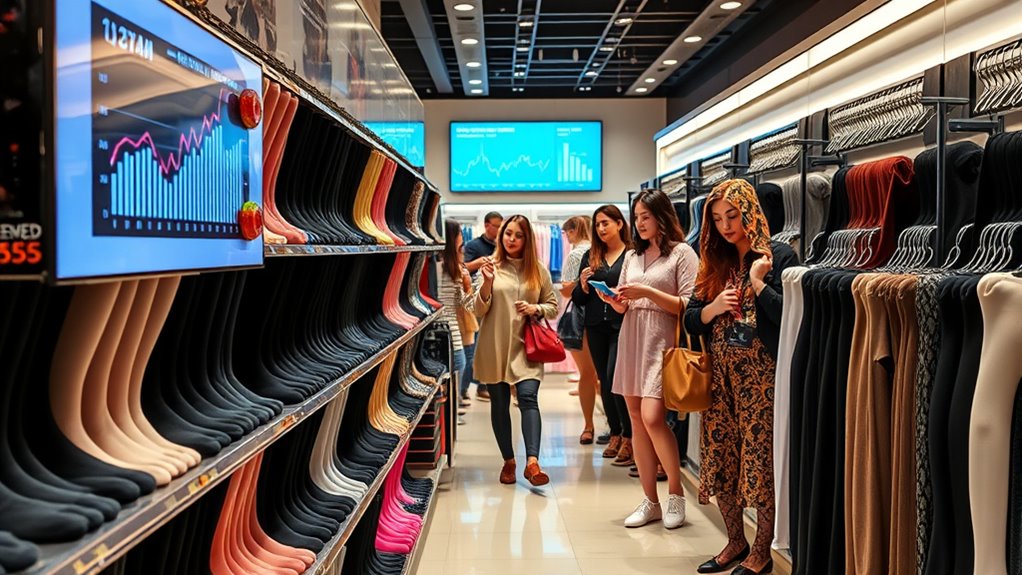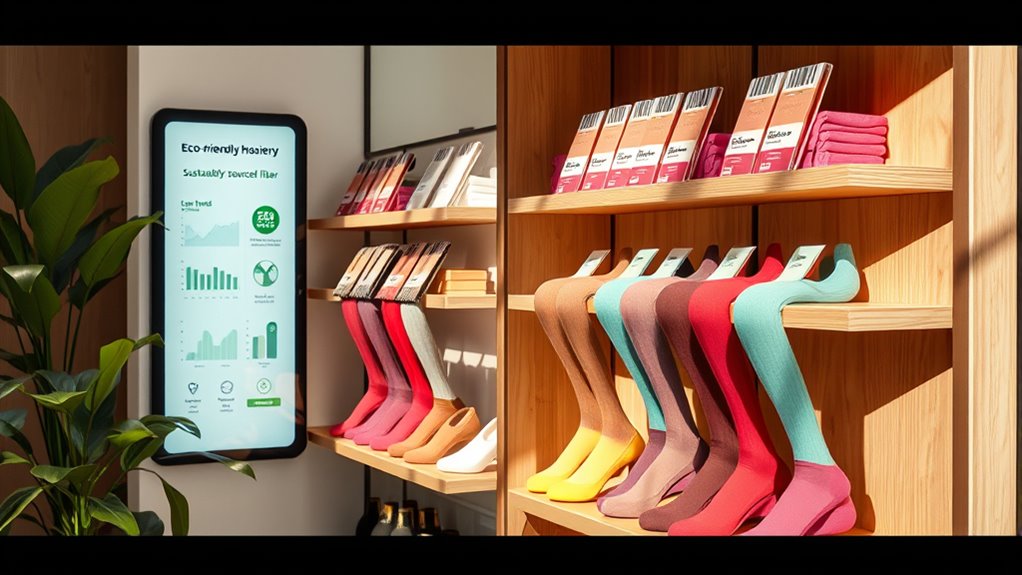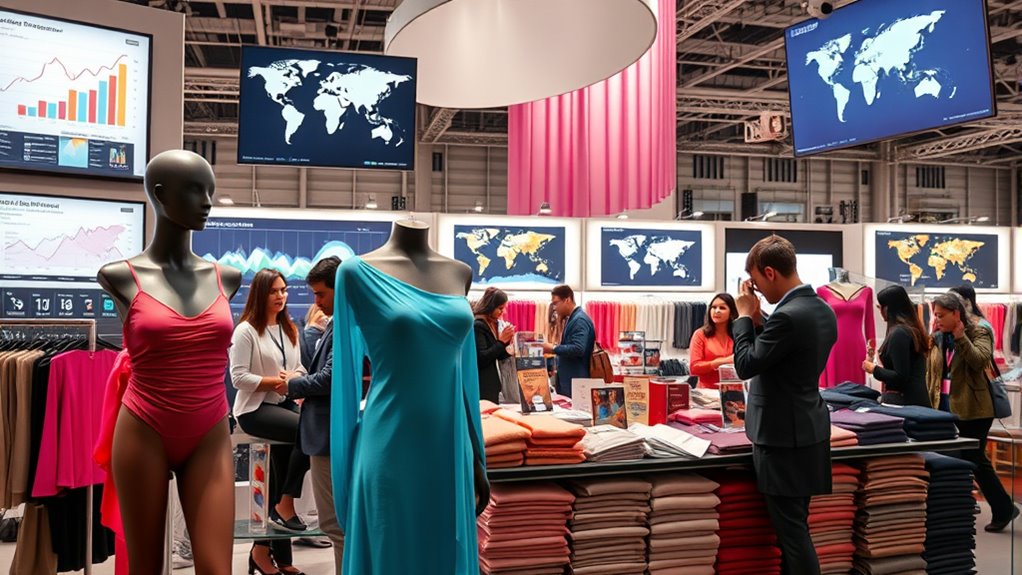The economics of hosiery are shaped by evolving consumer preferences for style, quality, and sustainability. Market growth is driven by demand for luxury brands, eco-friendly materials, and technological innovations in manufacturing. Digital marketing and social media also boost sales and brand visibility. Trade policies and global shifts influence supply and costs. By understanding these trends, you’ll see how the industry is adapting to meet changing demands—exploring this further reveals even more insights.
Key Takeaways
- Market growth is driven by shifting consumer preferences towards premium, designer, and sustainable hosiery products.
- Technological innovations enhance manufacturing efficiency, quality, and enable rapid adaptation to fashion trends.
- Sustainability and eco-friendly materials influence consumer demand and serve as key differentiators in the industry.
- Digital marketing and influencer collaborations significantly boost brand visibility and consumer engagement.
- Trade policies, currency fluctuations, and regional agreements impact supply chains, costs, and market accessibility.
Historical Evolution and Market Growth of Hosiery

The hosiery market has experienced significant growth and transformation over the centuries, evolving from practical clothing items to fashion staples. Originally, hosiery served functional purposes, but today, luxury branding plays a key role in defining high-end segments. These brands leverage retail distribution channels to reach a global audience, expanding their influence beyond traditional markets. As consumer preferences shifted towards premium quality and designer labels, the market responded by offering more sophisticated products. Retail distribution has become essential for luxury hosiery brands, ensuring visibility in upscale department stores and boutiques. This strategic focus on branding and distribution has fueled market growth, allowing hosiery to move from mere utilitarian wear to an essential element of contemporary fashion, appealing to a broader and more specialized consumer base. Understanding the importance of retail distribution helps brands expand their reach and reinforce their market presence.
Key Drivers Influencing Consumer Preferences

Consumer preferences in the hosiery market are driven by a combination of fashion trends, quality expectations, and lifestyle choices. You’re influenced by how often fashion cycles change, prompting quick shifts in style preferences. Price sensitivity also plays a key role, as consumers seek affordable options without sacrificing quality. Additionally, the rise of remote hackathons demonstrates how digital collaboration can foster innovation and new ideas, which can influence market offerings and consumer choices.
Impact of Sustainability and Eco-Friendly Materials

As awareness of environmental issues grows, sustainability and eco-friendly materials are becoming essential factors shaping consumer choices in the hosiery market. You now look for products made from sustainable fibers like recycled nylon or organic cotton, which reduce environmental impact. Brands that emphasize eco conscious branding appeal to your values, making you more likely to choose their hosiery over less sustainable options. The demand for eco-friendly materials pushes manufacturers to innovate with eco-aware textiles and transparent sourcing practices. This shift not only benefits the environment but also influences market trends, encouraging companies to prioritize sustainability in their product lines. As a result, sustainability has become a key differentiator, impacting purchasing decisions and fostering loyalty among environmentally conscious consumers like you.
Technological Innovations in Hosiery Manufacturing

You’ll notice that advanced knitting technologies are transforming how hosiery is produced, making fabrics more durable and comfortable. At the same time, manufacturers are increasingly using eco-friendly materials to reduce environmental impact. Automation in production speeds up processes and guarantees consistency, shaping the future of hosiery manufacturing. Additionally, leveraging automation in business can help manufacturers scale their operations efficiently and stay competitive in the evolving market.
Advanced Knitting Technologies
Advancements in knitting technologies are transforming the hosiery manufacturing landscape by enabling faster production, higher quality, and greater design versatility. Modern knitting machinery now incorporates automation and precision controls, allowing you to produce intricate patterns with consistent consistency. Fabric innovations, such as moisture-wicking and stretch-enhanced materials, are integrated directly into the knitting process, reducing the need for additional finishing steps. These technological improvements mean you can create more complex designs, improve product durability, and meet diverse consumer demands efficiently. As a result, manufacturers can quickly adapt to trends and customize products at scale. Overall, these innovations keep the hosiery industry competitive, responsive, and capable of delivering high-quality goods with innovative features that appeal to today’s consumers.
Eco-Friendly Material Use
Building on technological innovations that improved knitting precision and design flexibility, manufacturers now focus on eco-friendly materials to address environmental concerns. You’ll notice a rising use of sustainable fibers like organic cotton, bamboo, and recycled polyester in hosiery production. These fibers reduce waste and lessen the environmental footprint. Many brands now feature eco conscious labels, signaling their commitment to sustainability. This shift appeals to consumers seeking environmentally responsible options. Here’s a snapshot:
| Sustainable Fibers | Eco Conscious Labels |
|---|---|
| Organic Cotton | Certified Eco-Labels |
| Bamboo | Fair Trade Certified |
| Recycled Polyester | Green Seal Certification |
| Hemp | Carbon Neutral Labels |
| Tencel (Lyocell) | Sustainable Fabric Logos |
Additionally, advances in sustainable fiber processing techniques have enhanced the durability and comfort of eco-friendly hosiery.
Automation in Production
Automation has revolutionized hosiery manufacturing by streamlining production processes and increasing efficiency. You now benefit from robotic automation, which speeds up tasks like knitting and packing, reducing labor costs and minimizing errors. With robotic systems handling repetitive tasks, you can produce larger volumes faster and more reliably. Quality control has also improved markedly, as automation tools enable real-time monitoring of fabric consistency, stitching precision, and defect detection. This ensures higher product standards, reduces waste, and shortens lead times. By integrating advanced automation, you gain better control over production flow and consistency. Overall, these technological innovations allow you to meet rising consumer demand while maintaining competitive prices and quality. Automation isn’t just a trend; it’s transforming the core of hosiery manufacturing.
The Role of Social Media and Digital Marketing

You can see how influencers boost hosiery sales by showcasing new styles and reaching targeted audiences. Engaging visual content captures attention and encourages followers to explore different looks. As social media continues to grow, leveraging these tools becomes essential for staying competitive in the market. Incorporating digital marketing strategies into your campaign can further amplify reach and engagement.
Influencer Impact on Sales
Social media influencers have become powerful allies for hosiery brands, directly impacting sales through authentic endorsements and engaging content. They help build trust with consumers, often showcasing products in real-life settings that resonate. Celebrity endorsements boost credibility, while influencer collaborations create buzz and expand reach. Your audience is more likely to purchase when they see relatable figures promoting hosiery styles. To maximize impact, brands leverage influencer partnerships to highlight new collections, showcase versatility, and generate user-generated content. This strategy fosters a sense of community and authenticity that traditional advertising can’t match. Ultimately, influencers shape purchasing decisions by blending entertainment with genuine product appreciation, making them indispensable in today’s digital marketing landscape for hosiery brands.
- Authentic product demonstrations
- Increased brand visibility
- Targeted audience engagement
- Viral campaign potential
- Enhanced credibility through influencer collaborations
Visual Content Engagement
Visual content has become the cornerstone of digital marketing strategies for hosiery brands, capturing consumers’ attention quickly and effectively. Social media platforms leverage engaging visuals, videos, and stories to showcase products and connect with audiences. Virtual try-ons powered by augmented reality allow you to see how hosiery looks on you in real-time, reducing hesitation and boosting confidence in online purchases. These immersive experiences make consumers more likely to engage, share, and convert. By incorporating augmented reality and virtual try-ons into your marketing, you create a seamless shopping experience that blends digital innovation with visual appeal. Moreover, integrating beauty and skincare trends like eye patches into content can enhance visual storytelling and appeal to a broader audience. This approach not only increases engagement but also helps differentiate your brand in a crowded market, making your hosiery more appealing and accessible to modern consumers.
Global Market Dynamics and Trade Influences

Global market dynamics and trade influences play a crucial role in shaping the hosiery industry’s growth and distribution. You’ll notice that trade tariffs and import-export regulations directly impact costs and supply chains, influencing pricing and availability worldwide. Fluctuations in currency exchange rates can also affect competitiveness among exporters. Additionally, geopolitical tensions may lead to stricter trade policies, disrupting established routes. You should consider how regional trade agreements facilitate or hinder market access. Finally, global demand shifts, driven by changing consumer preferences and economic growth in emerging markets, shape production strategies. Changes in Gold IRA policies and regulations can also influence investment flows within the industry.
Future Outlook and Emerging Trends in Hosiery Demand

As consumer preferences evolve and technological innovations emerge, the hosiery market is poised for significant changes in demand. You’ll see a growing shift toward sustainable fibers, as buyers prioritize eco-friendly materials like recycled nylon and organic cotton. This trend aligns with increasing awareness of environmental impact and corporate responsibility. Additionally, demographic shifts will influence future demand; younger consumers seek stylish, functional hosiery, while aging populations demand comfort and durability. You may also notice an emphasis on customization and innovative designs, driven by technological advancements in textile manufacturing. As these trends develop, expect brands to adapt quickly, incorporating sustainable options and catering to diverse demographic needs. Embracing a mindset that values failure as a stepping stone to success can help brands innovate and stay resilient amidst these shifts. Staying ahead of these shifts will be key to capturing market share and meeting evolving consumer expectations.
Frequently Asked Questions
How Do Regional Cultural Differences Affect Hosiery Preferences Worldwide?
Regional cultural differences profoundly influence your hosiery preferences worldwide. You’ll notice that cultural attire and regional fashion shape what types of hosiery are popular, whether it’s sheer stockings in some areas or thermal tights elsewhere. These cultural influences determine style, color, and material choices. As a consumer, you adapt to local norms and fashion trends, making your hosiery choices a reflection of regional culture and traditions.
What Are the Pricing Strategies Used by Leading Hosiery Brands?
You should consider how leading hosiery brands use pricing psychology to attract consumers, like competitive pricing or premium charges for high-end products. They also focus on brand positioning, aligning prices with their target market’s perceptions—luxury brands set higher prices to convey exclusivity, while value brands use lower prices to appeal to budget-conscious shoppers. Understanding these strategies helps you recognize how brands influence your purchasing decisions.
How Does Seasonal Demand Influence Hosiery Sales Fluctuations?
Think of seasonal demand like a tide that rises and falls, shaping hosiery sales throughout the year. You’ll notice spikes during fall and winter, fueled by colder weather and holiday promotions. These seasonal sales fluctuations encourage brands to plan special offers, holiday discounts, and exclusive collections. By understanding these patterns, you can better anticipate when to buy or sell hosiery, maximizing your opportunities during peak seasons.
What Role Do Health and Comfort Considerations Play in Consumer Choices?
You prioritize health and comfort when choosing hosiery, and this influences your buying decisions. You look for fashion trends that align with your style while also considering environmental impact, opting for eco-friendly materials. Comfort features like breathability and stretchiness matter to you, ensuring that your hosiery not only looks good but also supports your well-being. Your choices reflect a balance between staying fashionable and being mindful of sustainability and health.
How Does Innovation in Materials Impact Hosiery Durability and Value?
Innovation in materials markedly boosts hosiery durability and value. By incorporating sustainable fibers and harnessing technological advancements, you get products that last longer and perform better. These innovations not only enhance comfort and strength but also meet growing consumer demand for eco-friendly options. As a result, you benefit from hosiery that offers better quality and sustainability, making your purchase more worthwhile and aligned with current market trends.
Conclusion
So, as you marvel at the ever-evolving hosiery market, remember that your choices—whether eco-friendly or trend-driven—actually shape its future. Ironically, in a world obsessed with innovation and sustainability, it’s still your mended tights and vintage stockings that keep this industry spinning. Keep shopping smart, and who knows? Maybe one day, even your grandma’s old socks will be the next big thing in fashion.






